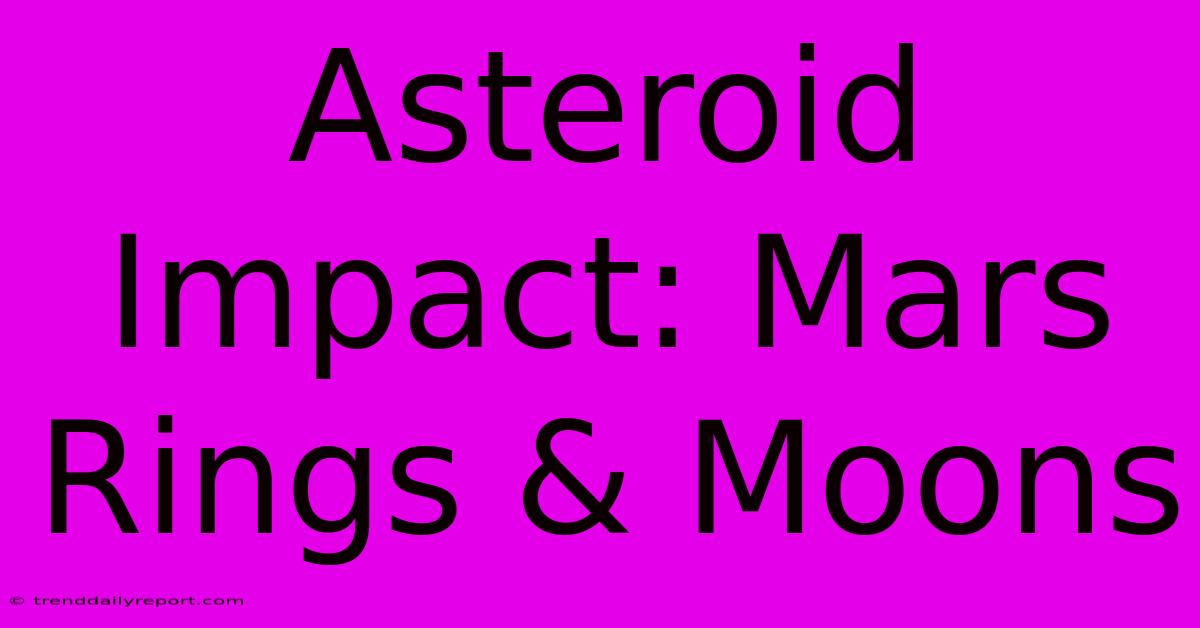Asteroid Impact: Mars Rings & Moons

Discover more detailed and exciting information on our website. Click the link below to start your adventure: Visit Best Website Asteroid Impact: Mars Rings & Moons. Don't miss out!
Table of Contents
Asteroid Impact: The Wild Story of Mars' Rings and Moons
Hey everyone, let's dive into something seriously cool – Mars' moons and how they might be connected to asteroid impacts! I've always been fascinated by space, and this topic, man, it's a total mind-bender. I mean, think about it: tiny Phobos and Deimos, Mars's moons, orbiting this dusty red planet... It’s like a cosmic mystery waiting to be solved. And the best part? A big piece of the puzzle might be asteroid impacts!
The Phobos and Deimos Mystery: More Than Meets the Eye?
So, you're probably thinking, "Okay, moons orbit planets. What's the big deal?" Well, the thing is, Phobos and Deimos are weird. They're unusually small, irregularly shaped, and their orbits are… well, kinda wonky. They don't perfectly fit the picture of how we think moons should form. They're more like giant space potatoes than elegant celestial bodies.
I remember when I first learned about this in college – I was totally stumped. It seemed like there had to be some alternative explanation for their existence. Turns out, my gut feeling was right! Many scientists believe that these moons are actually captured asteroids. This means they weren't formed alongside Mars billions of years ago; instead, they were wandering through space and got snagged by Mars' gravity.
Captured Asteroids: A Plausible Explanation
This captured asteroid theory is supported by their composition. Phobos and Deimos are pretty similar in terms of density and makeup to certain types of asteroids found in the asteroid belt between Mars and Jupiter. It's like finding a matching pair of shoes – a pretty strong clue!
But that's not the whole story. There's more to it than just a simple capture. The current models suggest a far more violent and dramatic history.
The Role of Asteroid Impacts: A Violent Past
Here’s where things get even more interesting (and a little more violent!). The prevailing theory is that numerous asteroid impacts played a crucial role in shaping the Martian moons. Think of it like this: a massive asteroid hits Mars. The resulting debris is flung into space. Over time, this debris gravitationally clumps together to form Phobos and Deimos. Pretty wild, huh?
Now, this isn’t just some crazy sci-fi idea. There's considerable evidence supporting this. The craters on both moons are pretty significant. Scientists use crater density to estimate the age of planetary surfaces – kinda like counting tree rings! The impact theory lines up nicely with the dating of the moons' surfaces.
More Than Just Moons: Ring Formation
This massive impact scenario isn't just important for understanding the formation of Phobos and Deimos; it might explain the possible existence of a Martian ring system! I know, sounds bonkers! But hear me out. As Phobos orbits Mars, its orbit is decaying. In the distant future (millions of years!), Phobos will get close enough to Mars' gravity that it will be ripped apart! This shredded Phobos would then form a ring around Mars, similar to Saturn's rings, only temporary and made from Martian moon fragments instead of ice particles!
This future Martian ring system isn't something I completely understand, and I’m sure some scientists would love to see a better model developed. Maybe I’ll go back to school and try to figure it out!
The Bottom Line: A Complex Story
In short, the story of Mars' moons is a fascinating testament to the violent and dynamic nature of our solar system. It's a story of asteroid impacts, gravitational capture, and potentially even the formation of a future ring system. It's a reminder that the universe isn't static; it's constantly changing, evolving, and surprising us with its wonders. This whole topic is something I truly enjoy teaching about – it just never gets old! So next time you look up at Mars, remember the dramatic story hidden within its tiny moons, and the potential for even more amazing discoveries yet to be made.

Thank you for visiting our website wich cover about Asteroid Impact: Mars Rings & Moons. We hope the information provided has been useful to you. Feel free to contact us if you have any questions or need further assistance. See you next time and dont miss to bookmark.
Featured Posts
-
Arsenals Victory Full Squad Plays Well
Nov 27, 2024
-
Abrar Dominates Shadabs Spot Uncertain
Nov 27, 2024
-
Lebanon Peace Israel Hezbollah Standoff Ends
Nov 27, 2024
-
Watch Spurs Vs Jazz Highlights
Nov 27, 2024
-
Soccer Season 2025 Key Dates
Nov 27, 2024
